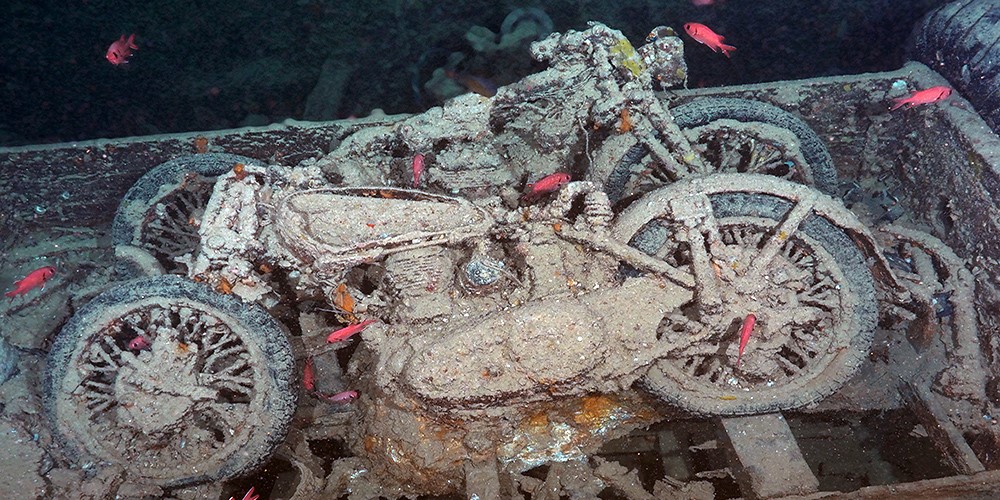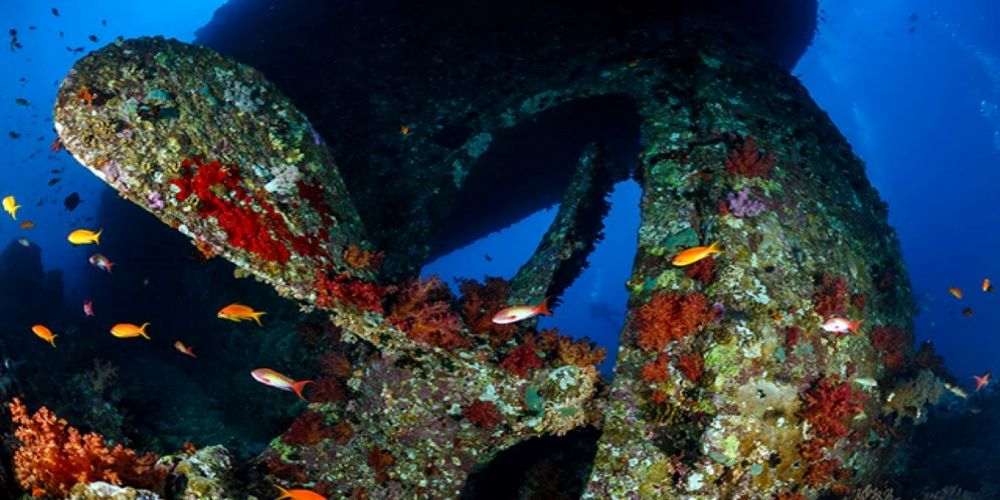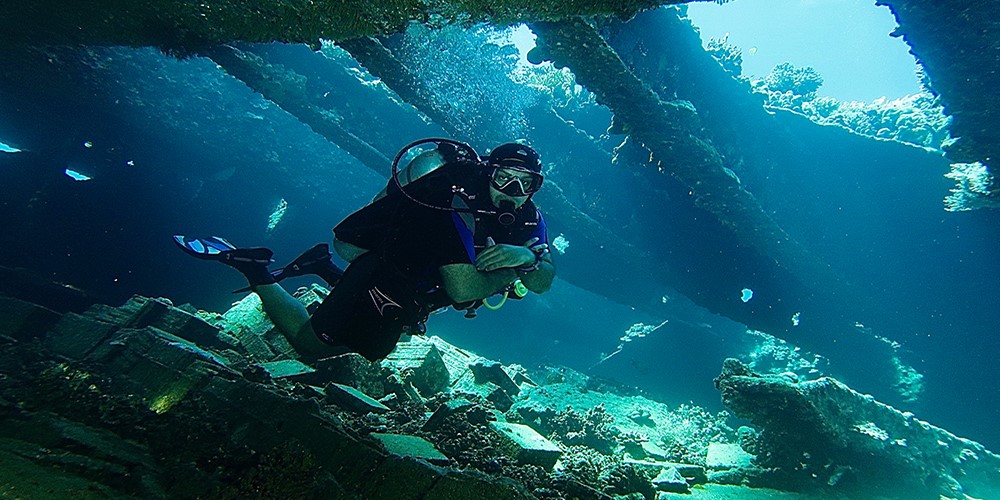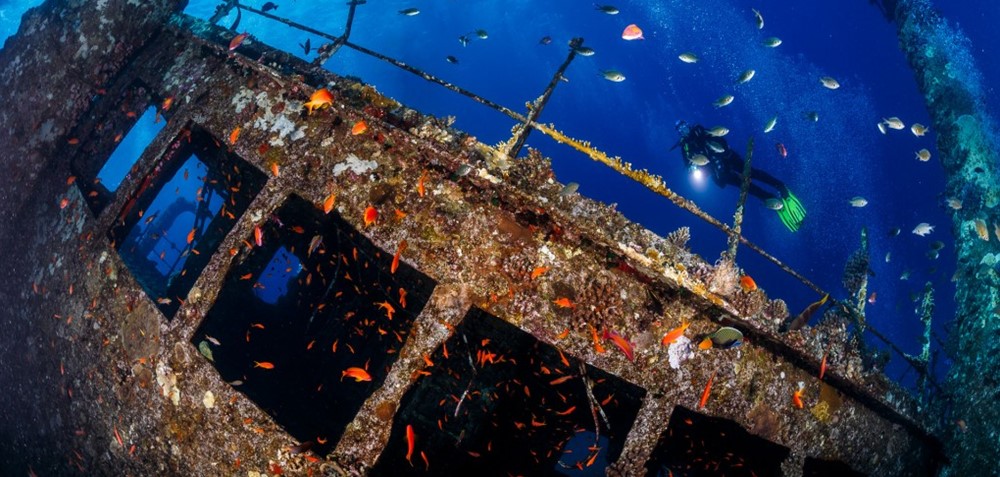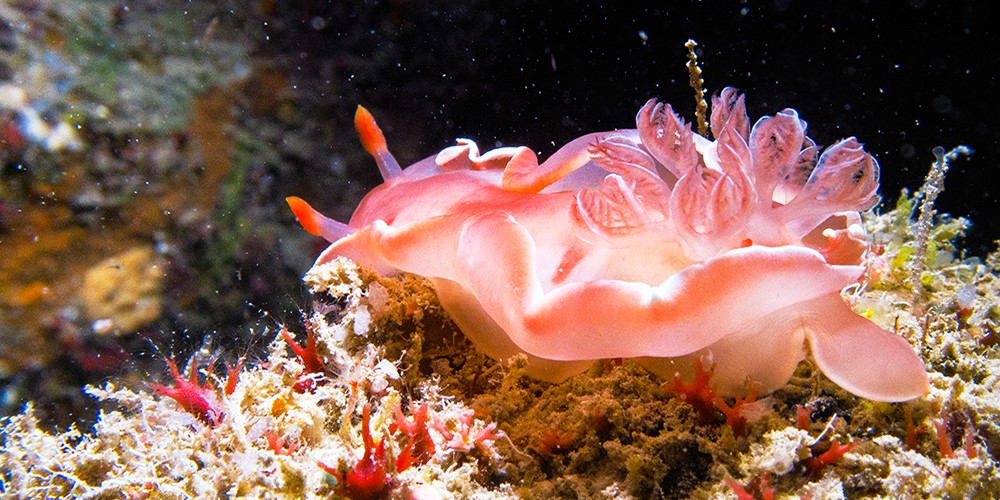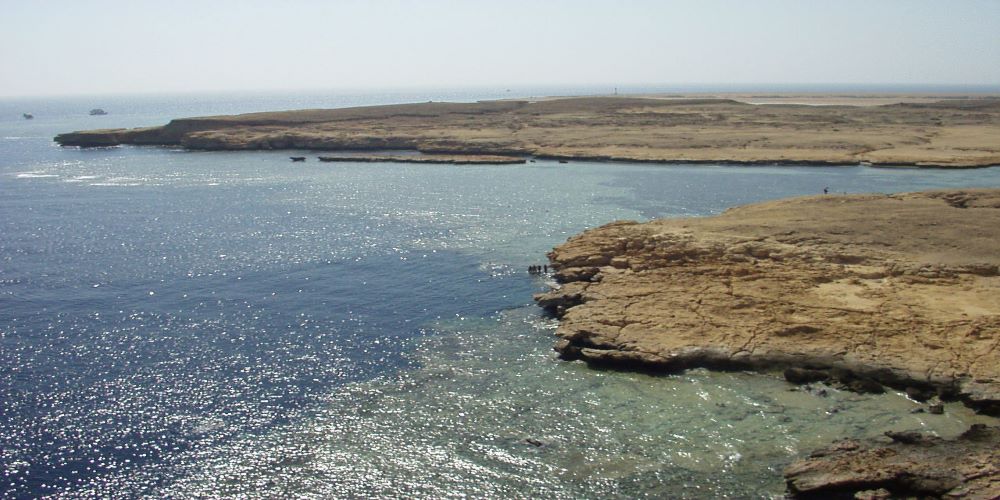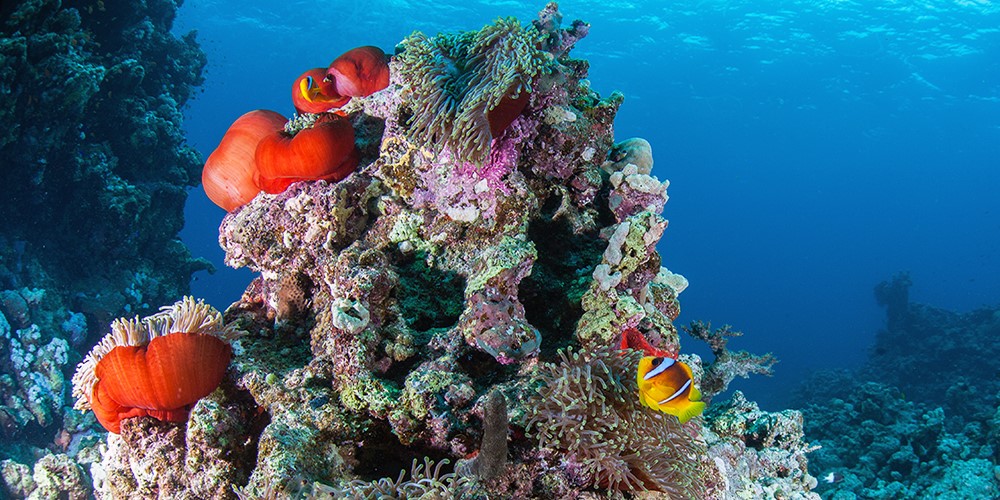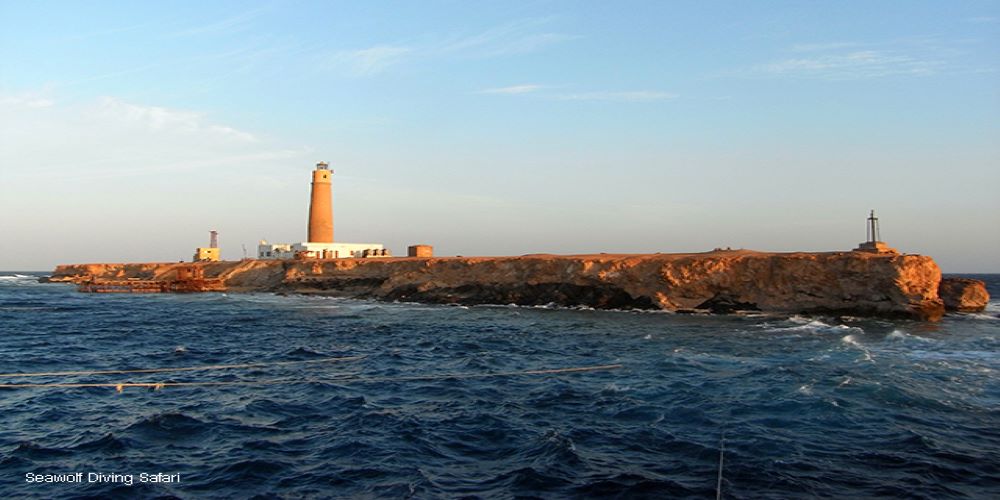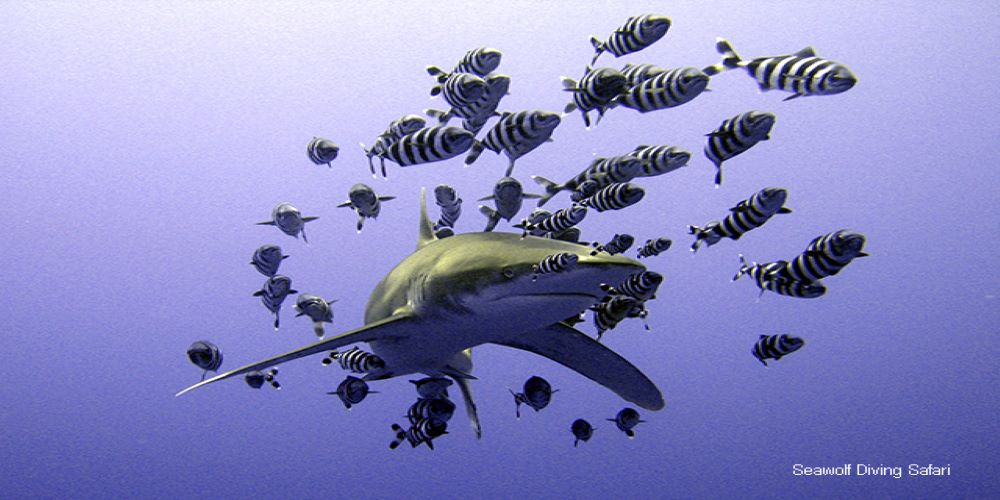Expect to see
SS Thistlegorm
The English ship was on her way to Egypt to supply the English Africa Corps with supplies when she was attacked by a German bomber on 6.10.1941 and sank.
The wreck lies upright on the seabed at a depth of 30 meters.
The cargo is especially interesting: tanks, trucks, weapons, motorcycles, railroad cars as well as a locomotive.
The Thistlegorm is a must for every Red Sea diver. She is a delight for wreck enthusiasts, not to mention her spectacular cargo.
But she also offers a variety of fish. Schools of barracudas or big tunas and snappers are not uncommon here. As an artificial reef, it also attracts countless coral fish.
Abu Nuhas / Carnatic
The Carnatic, on a voyage from Liverpool to Bombay with 27 crew, 203 passengers, and a cargo of cotton, copper plates, and 40,000 pounds sterling in gold, ran aground on the reef Shab Abu Nuhas on the night of September 13, 1869. The ship initially remained on the reef, but broke apart and sank on September 15, despite various rescue attempts .
Overconfidence in the ship's stability had a disastrous effect. Since the Carnatic had not been cleared and passengers and crew members were on board, the ship took 27 people down with it . The survivors first rescued themselves on Shadwan Island and were later recovered by the Sumatra.
In October 1869, a helmet diver recovered most of the gold cargo as well as 700 copper plates. Several bodies were also discovered - one victim was still stuck in a porthole through which he had tried unsuccessfully to escape. 8,000 pounds sterling could still be in the wreck. No one has found them yet - perhaps they were secretly salvaged or disappeared under coral.
The wreck was rediscovered in 1984 and has been a popular destination for Hurghada dive boats ever since. Since then, souvenir hunters have plundered it thoroughly. The Carnatic lies on its side at the base of the reef at a depth of 20 to 27 meters. In the middle the ship is badly damaged, bow and stern are well preserved. The wooden decks have rotted away so that it is safe to enter the interior. The hull is densely covered with stone and leather corals.
Abu Nuhas / Chrisoula
After several previous owners, she finally changed to the shipping company Clarion Marine and was given the name Chrisoula K. Under this name she also made her last voyage, which took her to the area of the Abu Nuhas reef in the Red Sea on August 30, 1981 with a cargo of cheap Italian floor tiles.
Due to a navigational error by the captain, the ship ran aground on the reef during the night of August 30 and sank.
Today the wreck lies in an optimal position for divers at a depth between 5 meters and a maximum of 25 meters.
The ship is in a slight inclination, the middle part is heavily damaged by the impact.
Abu Nuhas / Ghiannis
For a long time the front half, which had run up on the reef, remained stationary and indicated the place of the accident, then it too sank and lay down on the port side.
The aft half of the wreck lies somewhat inclined on the port side. Above the front of the quarterdeck rises the smokestack with the large letters "D". The "D" stands for the name of the shipping company: Danae.
In front of the chimney is the bridge deck, behind it other spaces, a huge winch, the bollards, the intact railing, and even the frame that used to support a large awning was not damaged in the sinking.
At the base of the funnel are narrow portholes leading into the engine room. The engines are an impressive sight with their long rows of cam arms, valves and pipes.
The middle section of the ship resembles a junkyard, as iron girders are bent and torn, and the sides lie collapsed on the seabed. This area of the wreck is teeming with crocodile fish, scorpion fish and parrot fish. Some groupers have also made their home here.
Gordon Reef
"Gordon Reef", the southernmost reef of the Strait of Tiran, has a length of about 900 meters and the reef top is just half a meter below the water surface. This is also the reason why we unfortunately cannot dive the cargo ship from Panama, the "Loullia", which was stranded on September 29, 1981.
In the southwest there is still an unmanned lighthouse and in the north a lighthouse ruin - unfortunately hardly recognizable, but the perfect search object for one or the other challenge! There are sandy moorings in the south, in the east as well as in the west with a depth of two to 10 meters.
Diving is mostly in the southern part, because here the drop-off edge is only between 25 and 30 meters and then later goes down to 50 meters. In the rest of the reef it's a steep descent from now on down to depths of 300 meters.
But finally we come to the colorful part of the explanations: in the "amphitheater", a sandy depression, we meet with a little luck scalloped hammerhead sharks, at the sight of which we are really speechless. The whitetip reef sharks, which are "sweet" in contrast to their counterparts, also grant us an audience here from time to time. It is not for nothing that this sandy depression is also called "Sharkpool". And the grass sticking out of the sand are usually red sea garden eels, the other highlights besides fire corals and gorgonians.
Ras Mohammed with Jolanda & Shark Reef
The cape takes its name from its rocky peak to the east, whose contours are reminiscent of a male profile with a beard - the head of Mohammed - carved in stone.
Ras Mohamed is one of the world's most famous dive sites and is located at the tip of Sinai. Two small reefs are connected by a vertical sloping wall.
Close to Shark Reef, a little further north, is Anemone City, an vast, shallow reef zone with numerous sea anemones and their red sea anemone fish and three-spotted damsel fish.
From Shark Reef, you can drift with the current along a steep wall that drops several 100 m to Jolanda Reef. The wall is completely covered with colourful corals. On the way to Jolanda Reef you reach a plateau with small boulders and coral islands. Once at the reef, you will see the scattered remains of the Yolanda wreck ,containerised sanitation facilities for the construction industry, now completely taken over by the life of the coral reef.
Blue Hole
This enormous hole along the coast in the coral reef with a diameter of 50 to 65 meters, is located 10 km north of Dahab in the east of the Sinai Peninsula. The drop-offs reach depths of considerable 70 to 110 meters.
The Blue Hole is a large hole in the reef top of the coastal fringing reef, which drops vertically to depths of 70 meters to 110 meters. It has a diameter of 50 to 65 meters.
The reason why the Blue Hole is considered the most dangerous dive site in the world is because of a connection to the open sea, which is called an "arch" because of its shape. It extends from the bottom of the Blue Hole up to a depth of 55 meters. At its upper end it is only a few meters wide and about 26 m long. Also at the outer edge the reef forms an almost vertical drop-off, which continues below the "exit" of the Blue Hole as a steep slope down to several hundred meters depth.
Canyon
Inside the canyon, depths range from 25 metres to its shallowest point (closest to the reef wall) to more than 50 metres. You must be an advanced diver to dive here. Technical divers can enter the canyon and follow it through a crack at 54-55 metres to the deepest exit.
Big Brother Island
The Big Brother has a length of 200m and a width of 60m. It is almost perpendicular to the north-south direction and is a steep-walled reef except for the eastern plateau. On the island you usually have the opportunity to stretch your feet, smoke a shisha with the lighthouse keeper or buy small souvenirs and enjoy the view from the lighthouse. This can change depending on the mood of the military.
The wreck of the "Numidia" lies diagonally on the reef from 15m to 75m depth. The general cargo ship hit the west side in 1901 after a navigation error. Its cargo consisted of rails and railroad wheels. It is spread around the wreck. The overgrowth of the wreck stops almost abruptly at 40 meters.
The Numidia is one of the most beautifully overgrown wrecks in the world.
The "Aida", which nestles against the reef on the southern side at a depth of 30m to 65m, has been resting there since she ran aground on the fringing reef in rough seas in 1953. She was to bring personnel for the lighthouse and material for the island. Storms in early 2010 have left the wreck a bit battered.
Around the western end there is usually high wave and some current. If it is possible to dive there in the afternoon, you have the chance to see gray reef sharks and between the wrecks hammerhead sharks from time to time.
On the eastern plateau you can see thresher sharks, also gray reef sharks can be seen there very often. Further on the north side there are nice notches and the reef wall is beautifully covered with soft and hard corals. In addition there are all kinds of fish.
To the south is the jetty that supplies the lighthouse. On both sides you will find small notches in two to five meters depth with gigantic schools of fish, hunting cornetfish, juvenile napoleon wrasse. In the open water area, hunting mackerels, tunas and barracudas often pass by.
Small Brother Island
Little Brother runs from northwest to southeast at 100m long and 50m wide. To the north, Little Brother runs somewhat wedge-shaped. Its height is 11 to 12m and it is surrounded by a fringing reef that seems to literally guard it. On the southeast side, where the moorings are, the reef drops steeply down to 10m, where there is a small reef nose that turns into a slight slope. It ends with an overhang at 37m. After that, the wall drops further into the depths. There, a lagoon like wall runs from the north to the large gorgonian garden that extends from 18m to well over 40m in the east.
Itinerary
xxx

 ENGLISH
ENGLISH
 РУССКИЙ
РУССКИЙ
 DEUTSCH
DEUTSCH

